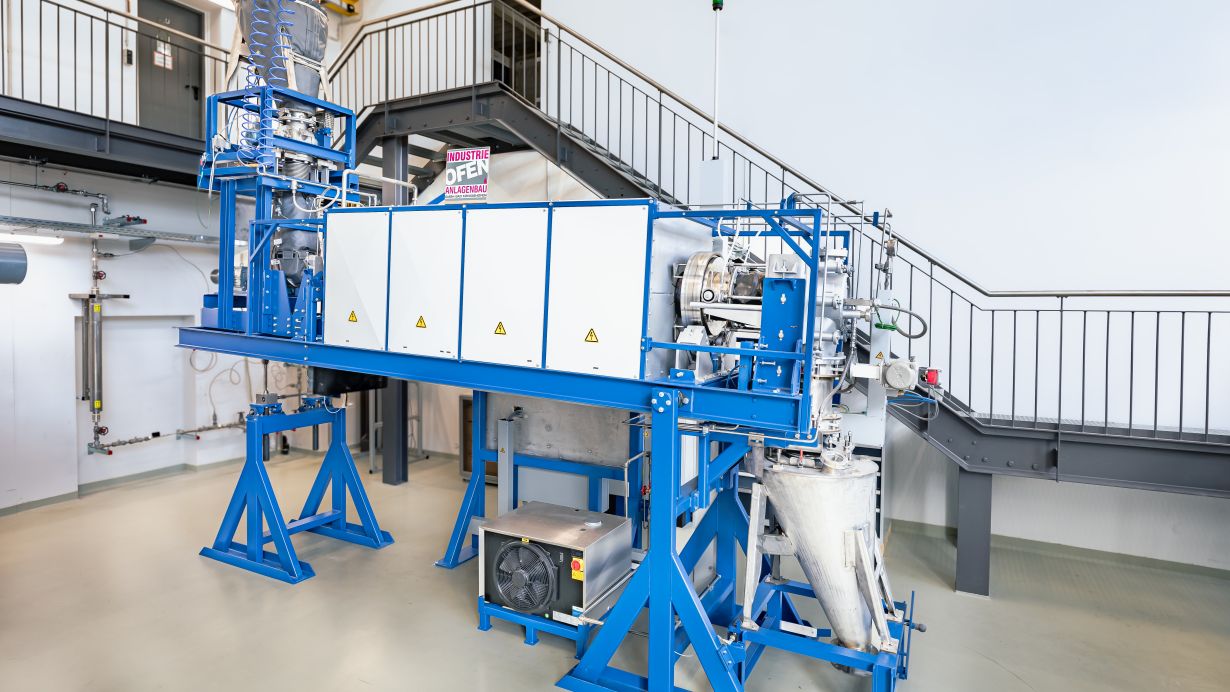Concrete production is one of the main sources of industrial greenhouse gas emissions. To limit such emissions, the Karlsruhe Institute of Technology (KIT) is developing net-zero circular concrete. With the launch of a pilot plant for belite cement clinker, an important step in its production has now been tested in practice.
Concrete production is responsible for 6 to 9 percent of global anthropogenic CO2 emissions. “The largest contribution to that comes from the production of cement, a precursor product,” said Dr. Peter Stemmermann from the Institute for Technical Chemistry (ITC) at KIT. “An important component of typical Portland cement is clinker, which is produced in an energy-intensive process by heating limestone.” Stemmermann’s research group has developed a clinker that is made instead from recycled concrete and only partly from limestone.
“This new pilot plant for recycled concrete is another milestone for climate action and the efficient use of resources in the construction industry. It enables important goals for building a regional circular economy, such as conserving natural resources, avoiding waste and reducing transport,” said Dr. Andre Baumann, State Secretary in Baden-Württemberg’s Ministry for the Environment, Climate and Energy Sector, at the dedication ceremony for KIT’s belite cement clinker pilot plant.
Energy-efficient Clinker Production
To produce belite cement clinker, the pilot plant uses an all-electric heating system powered by renewable energy and a carbon dioxide atmosphere, reducing the energy required for the process. “We can manage with a process temperature of 1000 instead of 1400 degrees Celsius in the rotary kiln,” Stemmermann said. Compared with conventional clinker production, the overall energy consumption is 40 percent lower. “The CO2 unavoidably emitted as a result of the limestone reaction in the kiln is captured and then bound to the recycled concrete in the second step of the process,” Stemmermann said. This second step is to be integrated in a future expansion of the pilot plant, which is currently capable of producing 100 kilograms of clinker per day.
Video: Net-Zero Circular Concrete – Concrete without Emissions Harmful to the Climate
Concrete in a Sustainable Resource Cycle
With the new pilot plant, the KIT researchers are testing an important component of a future process for the production of net-zero circular concrete. “The plant is based on the idea of recycling concrete,” said Dr. Rebekka Volk of the Institute for Industrial Production at KIT, which is developing the resource cycle in collaboration with the ITC team. “Instead of depositing high-grade concrete waste in landfills or using it for road construction, we can use buildings at the end of their life cycle as a resource to produce new high-quality construction materials.” Especially fine-grained concrete waste, which was rarely used in the past and normally disposed of in landfills, is used to produce the cement clinker.
Climate-neutral Thanks to Innovative Aggregate
Circular concrete from KIT’s plant is climate-neutral thanks to the direct link between the production of clinker and the production of carbonated aggregate (the coarse fill material in concrete). The CO2 from clinker production is used directly in the carbonation hardening of coarse-grained concrete waste, where it is permanently bound. The heat generated during clinker production is also used in this step, which takes place in an autoclave, making it particularly energy-efficient. “The result is a high-quality aggregate,” Stemmermann said. “We were able to prove beyond doubt that carbonation improves the microstructure of the aggregate by reducing its porosity.” The resulting aggregate is then processed with belite cement to produce circular concrete with a balanced overall carbon footprint.
More about the ITC’s Technical Mineralogy department
More about the KIT Energy Center
Being “The Research University in the Helmholtz Association”, KIT creates and imparts knowledge for the society and the environment. It is the objective to make significant contributions to the global challenges in the fields of energy, mobility, and information. For this, about 10,000 employees cooperate in a broad range of disciplines in natural sciences, engineering sciences, economics, and the humanities and social sciences. KIT prepares its 22,800 students for responsible tasks in society, industry, and science by offering research-based study programs. Innovation efforts at KIT build a bridge between important scientific findings and their application for the benefit of society, economic prosperity, and the preservation of our natural basis of life. KIT is one of the German universities of excellence.

